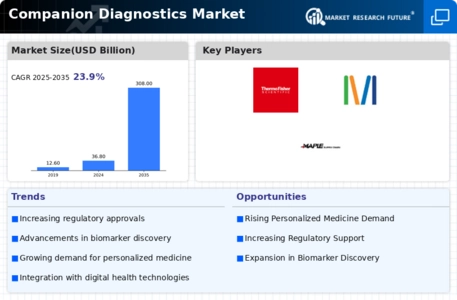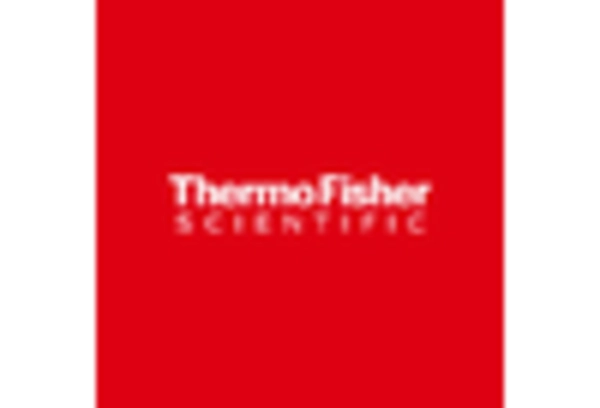Assays
Kits & Reagents
Software & Services
Polymerase Chain Reaction (PCR)
Next-Generation Sequencing (NGS)
In Situ Hybridization (ISH)
Immunohistochemistry (IHC)
Others
Cancer
Neurological Diseases
Infectious Diseases
Cardiovascular Diseases
Others
Pharmaceutical & Biopharmaceutical Companies
Contract Research Organizations
Laboratories
Others
North America Companion Diagnostics by Products & ServicesAssays
Kits & Reagents
Software & Services
North America Companion Diagnostics by TechnologyPolymerase Chain Reaction (PCR)
Next-Generation Sequencing (NGS)
In Situ Hybridization (ISH)
Immunohistochemistry (IHC)
Others
North America Companion Diagnostics by IndicationCancer
Neurological Diseases
Infectious Diseases
Cardiovascular Diseases
Others
North America Companion Diagnostics by End UserPharmaceutical & Biopharmaceutical Companies
Contract Research Organizations
Laboratories
Others
US Companion Diagnostics by Products & ServicesAssays
Kits & Reagents
Software & Services
US Companion Diagnostics by TechnologyPolymerase Chain Reaction (PCR)
Next-Generation Sequencing (NGS)
In Situ Hybridization (ISH)
Immunohistochemistry (IHC)
Others
US Companion Diagnostics by IndicationCancer
Neurological Diseases
Infectious Diseases
Cardiovascular Diseases
Others
US Companion Diagnostics by End UserPharmaceutical & Biopharmaceutical Companies
Contract Research Organizations
Laboratories
Others
CANADA Companion Diagnostics by Products & ServicesAssays
Kits & Reagents
Software & Services
CANADA Companion Diagnostics by TechnologyPolymerase Chain Reaction (PCR)
Next-Generation Sequencing (NGS)
In Situ Hybridization (ISH)
Immunohistochemistry (IHC)
Others
CANADA Companion Diagnostics by IndicationCancer
Neurological Diseases
Infectious Diseases
Cardiovascular Diseases
Others
CANADA Companion Diagnostics by End UserPharmaceutical & Biopharmaceutical Companies
Contract Research Organizations
Laboratories
Others
Europe Companion Diagnostics by Products & ServicesAssays
Kits & Reagents
Software & Services
Europe Companion Diagnostics by TechnologyPolymerase Chain Reaction (PCR)
Next-Generation Sequencing (NGS)
In Situ Hybridization (ISH)
Immunohistochemistry (IHC)
Others
Europe Companion Diagnostics by IndicationCancer
Neurological Diseases
Infectious Diseases
Cardiovascular Diseases
Others
Europe Companion Diagnostics by End UserPharmaceutical & Biopharmaceutical Companies
Contract Research Organizations
Laboratories
Others
Germany Outlook (USD Billion, 2019-2030)
Germany Companion Diagnostics by Products & ServicesAssays
Kits & Reagents
Software & Services
Germany Companion Diagnostics by TechnologyPolymerase Chain Reaction (PCR)
Next-Generation Sequencing (NGS)
In Situ Hybridization (ISH)
Immunohistochemistry (IHC)
Others
Germany Companion Diagnostics by IndicationCancer
Neurological Diseases
Infectious Diseases
Cardiovascular Diseases
Others
Germany Companion Diagnostics by End UserPharmaceutical & Biopharmaceutical Companies
Contract Research Organizations
Laboratories
Others
France Companion Diagnostics by Products & ServicesAssays
Kits & Reagents
Software & Services
France Companion Diagnostics by TechnologyPolymerase Chain Reaction (PCR)
Next-Generation Sequencing (NGS)
In Situ Hybridization (ISH)
Immunohistochemistry (IHC)
Others
France Companion Diagnostics by IndicationCancer
Neurological Diseases
Infectious Diseases
Cardiovascular Diseases
Others
France Companion Diagnostics by End UserPharmaceutical & Biopharmaceutical Companies
Contract Research Organizations
Laboratories
Others
UK Companion Diagnostics by Products & ServicesAssays
Kits & Reagents
Software & Services
UK Companion Diagnostics by TechnologyPolymerase Chain Reaction (PCR)
Next-Generation Sequencing (NGS)
In Situ Hybridization (ISH)
Immunohistochemistry (IHC)
Others
UK Companion Diagnostics by IndicationCancer
Neurological Diseases
Infectious Diseases
Cardiovascular Diseases
Others
UK Companion Diagnostics by End UserPharmaceutical & Biopharmaceutical Companies
Contract Research Organizations
Laboratories
Others
ITALY Companion Diagnostics by Products & ServicesAssays
Kits & Reagents
Software & Services
ITALY Companion Diagnostics by TechnologyPolymerase Chain Reaction (PCR)
Next-Generation Sequencing (NGS)
In Situ Hybridization (ISH)
Immunohistochemistry (IHC)
Others
ITALY Companion Diagnostics by IndicationCancer
Neurological Diseases
Infectious Diseases
Cardiovascular Diseases
Others
ITALY Companion Diagnostics by End UserPharmaceutical & Biopharmaceutical Companies
Contract Research Organizations
Laboratories
Others
Spain Companion Diagnostics by Products & ServicesAssays
Kits & Reagents
Software & Services
Spain Companion Diagnostics by TechnologyPolymerase Chain Reaction (PCR)
Next-Generation Sequencing (NGS)
In Situ Hybridization (ISH)
Immunohistochemistry (IHC)
Others
Spain Companion Diagnostics by IndicationCancer
Neurological Diseases
Infectious Diseases
Cardiovascular Diseases
Others
Spain Companion Diagnostics by End UserPharmaceutical & Biopharmaceutical Companies
Contract Research Organizations
Laboratories
Others
Rest of Europe Companion Diagnostics by Products & ServicesAssays
Kits & Reagents
Software & Services
REST OF EUROPE Companion Diagnostics by TechnologyPolymerase Chain Reaction (PCR)
Next-Generation Sequencing (NGS)
In Situ Hybridization (ISH)
Immunohistochemistry (IHC)
Others
REST OF EUROPE Companion Diagnostics by IndicationCancer
Neurological Diseases
Infectious Diseases
Cardiovascular Diseases
Others
REST OF EUROPE Companion Diagnostics by End UserPharmaceutical & Biopharmaceutical Companies
Contract Research Organizations
Laboratories
Others
Asia-Pacific Companion Diagnostics by Products & ServicesAssays
Kits & Reagents
Software & Services
Asia-Pacific Companion Diagnostics by TechnologyPolymerase Chain Reaction (PCR)
Next-Generation Sequencing (NGS)
In Situ Hybridization (ISH)
Immunohistochemistry (IHC)
Others
Asia-Pacific Companion Diagnostics by IndicationCancer
Neurological Diseases
Infectious Diseases
Cardiovascular Diseases
Others
Asia-Pacific Companion Diagnostics by End UserPharmaceutical & Biopharmaceutical Companies
Contract Research Organizations
Laboratories
Others
China Companion Diagnostics by Products & ServicesAssays
Kits & Reagents
Software & Services
China Companion Diagnostics by TechnologyPolymerase Chain Reaction (PCR)
Next-Generation Sequencing (NGS)
In Situ Hybridization (ISH)
Immunohistochemistry (IHC)
Others
China Companion Diagnostics by IndicationCancer
Neurological Diseases
Infectious Diseases
Cardiovascular Diseases
Others
China Companion Diagnostics by End UserPharmaceutical & Biopharmaceutical Companies
Contract Research Organizations
Laboratories
Others
Japan Companion Diagnostics by Products & ServicesAssays
Kits & Reagents
Software & Services
Japan Companion Diagnostics by TechnologyPolymerase Chain Reaction (PCR)
Next-Generation Sequencing (NGS)
In Situ Hybridization (ISH)
Immunohistochemistry (IHC)
Others
Japan Companion Diagnostics by IndicationCancer
Neurological Diseases
Infectious Diseases
Cardiovascular Diseases
Others
Japan Companion Diagnostics by End UserPharmaceutical & Biopharmaceutical Companies
Contract Research Organizations
Laboratories
Others
India Companion Diagnostics by Products & ServicesAssays
Kits & Reagents
Software & Services
India Companion Diagnostics by TechnologyPolymerase Chain Reaction (PCR)
Next-Generation Sequencing (NGS)
In Situ Hybridization (ISH)
Immunohistochemistry (IHC)
Others
India Companion Diagnostics by IndicationCancer
Neurological Diseases
Infectious Diseases
Cardiovascular Diseases
Others
India Companion Diagnostics by End UserPharmaceutical & Biopharmaceutical Companies
Contract Research Organizations
Laboratories
Others
Australia Companion Diagnostics by Products & ServicesAssays
Kits & Reagents
Software & Services
Australia Companion Diagnostics by TechnologyPolymerase Chain Reaction (PCR)
Next-Generation Sequencing (NGS)
In Situ Hybridization (ISH)
Immunohistochemistry (IHC)
Others
Australia Companion Diagnostics by IndicationCancer
Neurological Diseases
Infectious Diseases
Cardiovascular Diseases
Others
Australia Companion Diagnostics by End UserPharmaceutical & Biopharmaceutical Companies
Contract Research Organizations
Laboratories
Others
Rest of Asia-Pacific Companion Diagnostics by Products & ServicesAssays
Kits & Reagents
Software & Services
Rest of Asia-Pacific Companion Diagnostics by TechnologyPolymerase Chain Reaction (PCR)
Next-Generation Sequencing (NGS)
In Situ Hybridization (ISH)
Immunohistochemistry (IHC)
Others
Rest of Asia-Pacific Companion Diagnostics by IndicationCancer
Neurological Diseases
Infectious Diseases
Cardiovascular Diseases
Others
Rest of Asia-Pacific Companion Diagnostics by End UserPharmaceutical & Biopharmaceutical Companies
Contract Research Organizations
Laboratories
Others
Rest of the World Companion Diagnostics by Products & ServicesAssays
Kits & Reagents
Software & Services
Rest of the World Companion Diagnostics by TechnologyPolymerase Chain Reaction (PCR)
Next-Generation Sequencing (NGS)
In Situ Hybridization (ISH)
Immunohistochemistry (IHC)
Others
Rest of the World Companion Diagnostics by IndicationCancer
Neurological Diseases
Infectious Diseases
Cardiovascular Diseases
Others
Rest of the World Companion Diagnostics by End UserPharmaceutical & Biopharmaceutical Companies
Contract Research Organizations
Laboratories
Others
Middle East Companion Diagnostics by Products & ServicesAssays
Kits & Reagents
Software & Services
Middle East Companion Diagnostics by TechnologyPolymerase Chain Reaction (PCR)
Next-Generation Sequencing (NGS)
In Situ Hybridization (ISH)
Immunohistochemistry (IHC)
Others
Middle East Companion Diagnostics by IndicationCancer
Neurological Diseases
Infectious Diseases
Cardiovascular Diseases
Others
Middle East Companion Diagnostics by End UserPharmaceutical & Biopharmaceutical Companies
Contract Research Organizations
Laboratories
Others
Africa Companion Diagnostics by Products & ServicesAssays
Kits & Reagents
Software & Services
Africa Companion Diagnostics by TechnologyPolymerase Chain Reaction (PCR)
Next-Generation Sequencing (NGS)
In Situ Hybridization (ISH)
Immunohistochemistry (IHC)
Others
Africa Companion Diagnostics by IndicationCancer
Neurological Diseases
Infectious Diseases
Cardiovascular Diseases
Others
Africa Companion Diagnostics by End UserPharmaceutical & Biopharmaceutical Companies
Contract Research Organizations
Laboratories
Others
Latin America Companion Diagnostics by Products & ServicesAssays
Kits & Reagents
Software & Services
Latin America Companion Diagnostics by TechnologyPolymerase Chain Reaction (PCR)
Next-Generation Sequencing (NGS)
In Situ Hybridization (ISH)
Immunohistochemistry (IHC)
Others
Latin America Companion Diagnostics by IndicationCancer
Neurological Diseases
Infectious Diseases
Cardiovascular Diseases
Others
Latin America Companion Diagnostics by End UserPharmaceutical & Biopharmaceutical Companies
Contract Research Organizations
Laboratories
Others

















Leave a Comment